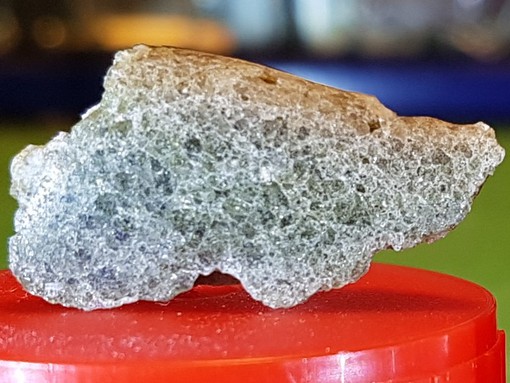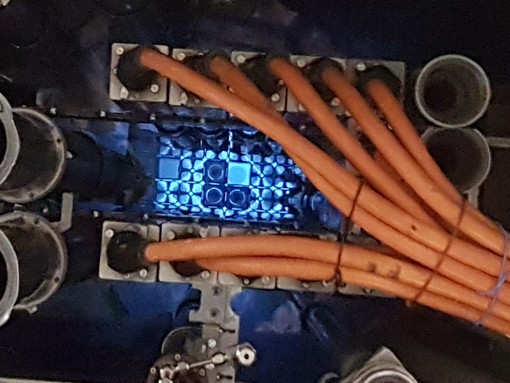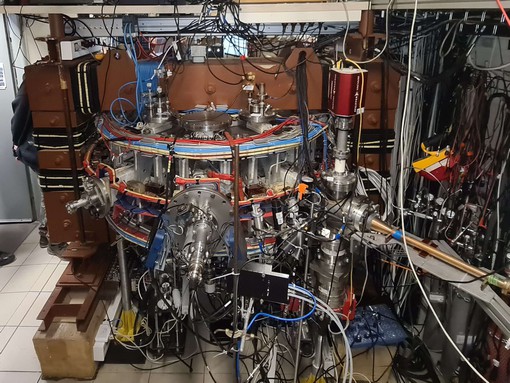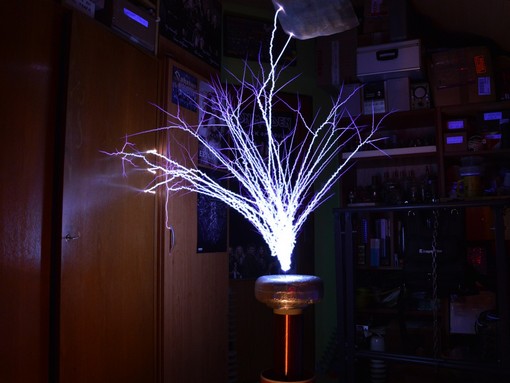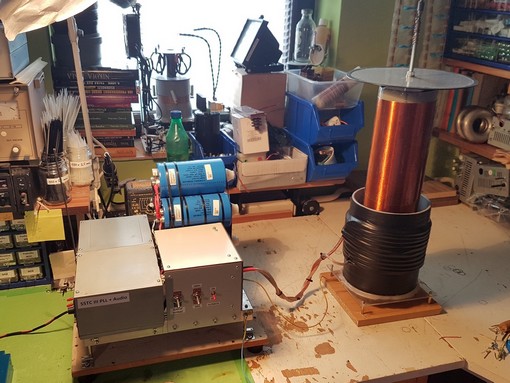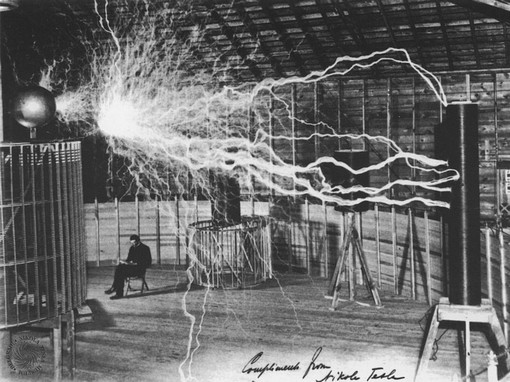CCD and CMOS sensors from digital cameras as radioactive radiation detectors. Simple webcam modification in conjunction with Theremino ParticleDetector software for radioactivity detection.
CCD and CMOS sensors in digital cameras and video cameras create (white) dots in video or long-exposure photos by exposing them to radioactive radiation or X-rays. If the camera is covered with a thin aluminium foil so that no light passes through and the image is completely black, then dots or even stronger noise can be seen depending on the intensity of the radiation. Both sensor systems have matrix with silicon photodiodes sensitive to light, i.e. photons. With a source of radioactive or X-ray radiation, it is then possible to observe graining by passing a particle through the sensor matrix. This phenomenon was also exploited by Danyk in his X-rays, where he used a CCD sensor to piece together images of components from multiple smaller grainy photographs.
The active particle-sensitive element is a photodiode (figure below). The ionizing particle enters the sensitive region from the "top window" and on its passage produces several hundred electron/hole pairs, which are collected by the cathode/anode of the diode and produce a signal that is digitized. Particle detection is local on the chip, a dot or thin smudge/dash appears on the image as the particle passes through.
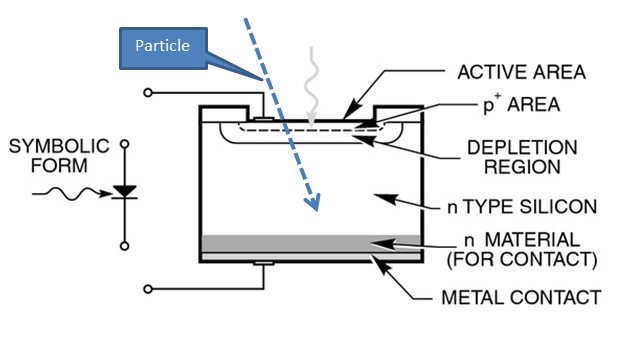
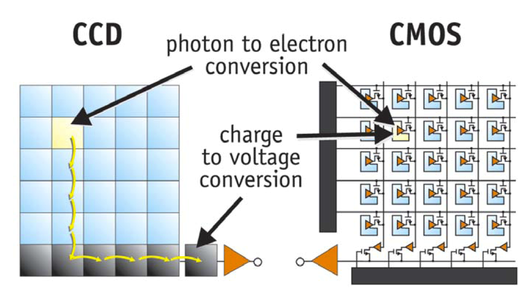
CCD and CMOS sensors in cameras are not designed and optimized for particle detection, so the efficiency of such detection is quite low, but feasible even at home from an ordinary cheap webcam. The fact that the sensitive area on the chip is very thin is also a problem.
Alpha particles are not detected because the sensor is protected by a layer of glass or other transparent material that completely blocks the alpha particles. Not to mention the aluminium foil used to cover the sensor.
Beta particles (electrons and positrons) are partially absorbed by the surface protection of the sensor, but a high percentage reaches the sensitive part and is detected. Plus some shielding with aluminium foil.
Gamma radiation has a low sensitivity for the sensor, higher sensor sensitivity will be at lower gamma energies, what "plays into the cards" of X-ray radiation which should be much more detectable. At the same time, the well-known high graininess of the video image for X-ray. This sensitivity will be due to the small thickness of the sensitive area of the sensor.
Webcam modification
The modification is simple, it is necessary to disassemble the webcam, remove the optics and leave only the bare sensor covered with a thin aluminum foil.
https://vn-experimenty.eu/en/radioaktivita/detektor-radioaktivity-cez-webkameru.html#sigProId70865fa567
Theremino particle detector
Theremino ParticleDetector software was created to create the images recorded by the webcam. This SW performs an integration of the images to achieve a sort of long exposure from the video. In this way, the particle traces are not erased, but at each frame cycle they are accumulated and each particle is counted.
https://vn-experimenty.eu/en/radioaktivita/detektor-radioaktivity-cez-webkameru.html#sigProId47e0402a16
The application gives the option to set a minimum energy (0 – 255) so that interference events caused by sensor noise are not counted. Most of the noise can be cancelled by setting this value between 5 – 20.
The START / STOP control starts and stops frame recording and particle counting. RESET resets the integration time and particle count.
During the recording, the events that are caused by the particle detection are counted and displayed in the "Particles" field, the total recording time is displayed in the "Time" field. The ratio between these two values corresponds to the quantity CPS (Counts Per Seconds), then after conversion CPM (Counts Per Minute). In the figure below this is 1.95CPS or also 116.98CPM.
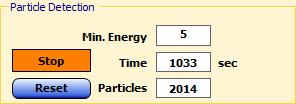
The next window is the camera settings, I did all the measurements in the article with this setting. It is possible to play around with this a bit for better viewing and detection of the particles themselves, depending also on the webcam used.
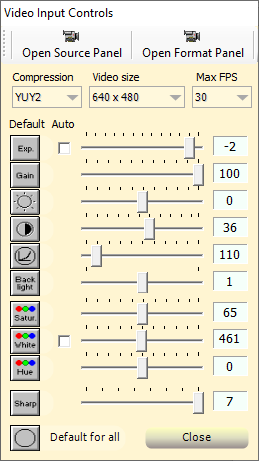
The source for the article itself and the idea is here: http://physicsopenlab.org/
Download SW here or in the attached source article: Theremino ParticleDetector V1.0
My measurements and results
First, in the photos below, measured radioactive samples, mostly minerals. These are all smaller samples, which are nice to lay directly on the thin aluminum foil over the webcam sensor. More on other radioactive objects and minerals in the second article Radioactive Objects and Minerals.
- Uranium glass (glass with uranium admixture of 2%)
- Monazite sand (contains thorium)
- Uraninite (uranium mineral)
- Autunite (uranium mineral)
- Torbernite (uranium mineral)
- Uraninite + Torbernite (uranium mineral)

https://vn-experimenty.eu/en/radioaktivita/detektor-radioaktivity-cez-webkameru.html#sigProIdb150bc9977
Measured results from Theremin, radioactive samples consecutively from 1 to 6:
https://vn-experimenty.eu/en/radioaktivita/detektor-radioaktivity-cez-webkameru.html#sigProId226743e81e
Table and graphs from measured data. As can be seen, uranium glass and uraninite are very weak. When measured with a GM tube they show much higher activity. Such measurements with a webcam are just very indicative for comparison and rather to show you that even something like this works and can be implemented at home very easily. All you need for this is an unnecessary webcam. You don't even think much about measuring the radioactive background with such a small sensor with such low sensitivity, in the end I tested that too.
Still for to compare uranium glass and uraninite. If I put them in a cloud chamber, uranium glass shows minimal activity and decay, while uraninite goes "crazy" with high activity and significant decay. Which doesn't match the measured CPM values at all. The remaining CPM ratios could still be, let's say, about OK.
- Monazite sand
- Uranium glass
- Uraninite
- Autunite
- Torbernite
- Autunite + Torbernite

Comparison of radioactive samples (graph below)
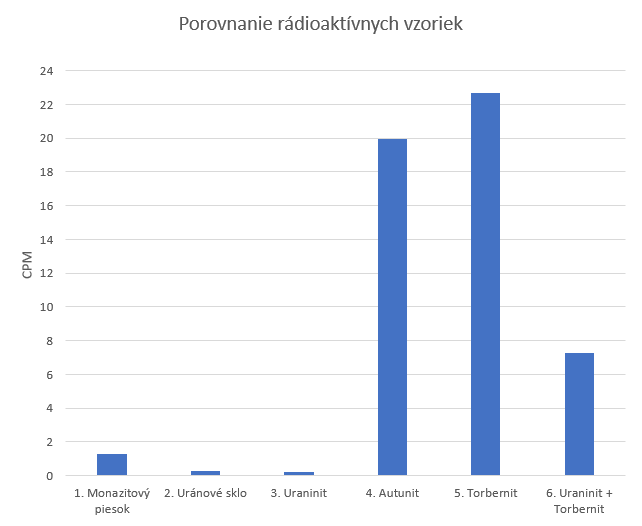
Measurement of radioactive background:
Finally, I tried one more measurement of the natural radioactive background and here is the result. I detected up to 3 particles in 95 minutes :) Then the last picture is a demonstration if a bit of light penetrates through the slit onto the sensor.
https://vn-experimenty.eu/en/radioaktivita/detektor-radioaktivity-cez-webkameru.html#sigProId3dc54b487d





